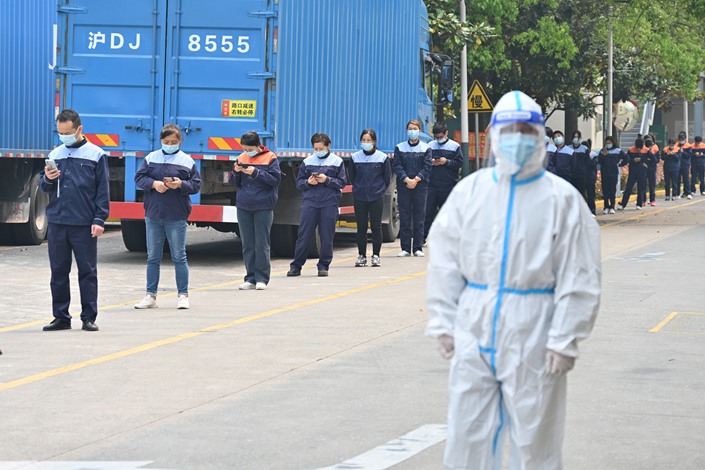
Covid-19 remains a tough battle in China. Concentrated resurgences in some areas have resulted in company suspensions and trouble for local residents. In the current wave of the outbreak, more specifically from mid-to-late March, more than 1,000 enterprises above a certain size in Shanghai were made to instigate closed-loop production, stated the chief engineer of the Shanghai Municipal Commission of Economy and Informatization at an April 19 news briefing. In 2021, Shanghai had 8,879 enterprises above the designated size, with 1.756 million employees, according to official data. Looking at these numbers, it is clear that the task of resuming work and production is an arduous one, as it not only requires attention to enterprises’ business development but also for people’s wellbeing. Furthermore, it is vital for the establishment of “dual circulation” and China’s steady economic and social development.
Currently, an alarming opinion is that epidemic prevention efforts are a government issue while resuming work and production is in the hands of enterprises. It is true that enterprises play a dominant role in resuming work and production, but in the current context, many of these efforts go far beyond enterprises’ capabilities and rely on effective top-down coordination by the government. The government must create favorable conditions for work resumption to be possible. For this reason, governments at all levels should issue practical policies to coordinate the fight against Covid-19 and promote economic development. To create favorable conditions, the first step is disease control, which must be done in a scientific and realistic way. Governments should not adopt a “one-size-fits-all” approach or over-complicate the process. Nor should they hinder enterprises’ resumption of work and production, directly or indirectly, because of the fear of being blamed for disrupting pandemic prevention and control.
The government in its turn must be made aware of the urgency of resuming work and production. According to Caixin’s incomplete statistics, as of April 17, 22 cities or regions in China were employing region-based static management, affecting about 29.85 million residents. If the population of China’s largest city Shanghai were added to this, the number would double. These lockdowns not only affect the cities or regions themselves but the spillover effect is reflected in the supply chain and logistics sector. In recent days, several entrepreneurs have voiced concerns. Some believe that technology and industry, especially the automobile industry as it is closely connected to Shanghai’s supply chain, will suffer a large-scale suspension as May begins without work and production having resumed. It is clear that this cannot be delayed.
Amidst the mounting downward pressure on China’s economy, long-term shutdowns cripple already weakened economic development. The outbreak has had a strong adverse impact on both supply and demand. Some economists have warned of the risks of a double-dip in China’s economic growth in the second quarter of this year. Changes in international industrial patterns are also cause for concern. The long-term static management of many regions will undoubtedly erode the production capacity of Chinese enterprises, and many overseas orders have already been shunted to other regions such as Southeast Asia, where pandemic prevention has loosened. Being the first country to have gotten Covid-19 under control, China benefited greatly from its export sector since 2020, as it was able to resume production and undertake overseas orders. In the context of the gradual dropping of pandemic prevention rules internationally, if various parts of China failed to effectively juggle pandemic containment and economic development, the loss of international orders would become even more pressing. Moreover, economic recovery often lags. The longer the shutdown, the more severe the impact on the economy, and the more difficult it will be to recover.
The key for enterprises to resume business is to properly handle the relationship between production resumption and epidemic prevention and control. The two aspects may seem mutually contradictory, and some claim that the current shutdown will help ensure a better resumption of work and production in the future. Although this statement is true to some extent, it seems to suggest that we should continue to fight the pandemic regardless of the cost. This is, however, unreasonable. A scientific and sustainable response to the outbreak and the well-being of the people must be underpinned by economic support. Therefore, equal emphasis should be given to pandemic control and economic development. Most important of all is to adopt targeted prevention and control to provide basic conditions for economic development. Recently, during his inspection tour of Hainan, President Xi Jinping said that prevention and control efforts should not be relaxed, and stressed that “in response to new features of the mutated virus, we must enhance our capabilities in scientific and precise prevention and control, improve contingency plans, and strictly implement regular prevention and control measures to minimize the impact of the pandemic on economic and social development.”
While encouraging business resumption, companies’ responsibility for epidemic prevention and control must also be made clear. To this end, a set of flexible basic pandemic norms must be formed and strictly followed. According to documents such as the “Guidelines for Epidemic Prevention and Control of Industrial Enterprises Resuming Work and Production (First Edition),” all local governments have set extremely high requirements that enterprises must meet before they are allowed to resume work and production. Companies that have earnestly fulfilled their responsibilities should not be treated too harshly if the occasional outbreak should occur. No company hopes to see Covid-19 break out in their factory. Prevention and control measures should be adjusted as and when necessary, according to the pandemic situation. These adjustments should take into consideration the legal rights of companies and employees, the living conditions of employees, their labor protection and family lives, and most importantly, their physiological and psychological state when under closed-loop management. Moreover, problems facing businesses as they get back to work should be handled in a timely manner. Of all the problems, logistics is the most prominent. To unblock logistics links, the central government has made clear arrangements, and local governments should comply with them and coordinate with each other.
In addition to the flow of employees and logistics, work and production resumption also entails the reopening of various infrastructures. As large-scale flow poses new challenges to static prevention and control, it is vital that we have a good enough understanding of scientific and precise prevention and control. Guaranteeing people’s livelihoods during the fight against Covid-19 relies on three aspects: science, market and information. The same goes for work and production resumption. Adopting a one-size-fits-all approach and taking excessive control and prevention measures is irresponsible and to put it bluntly, wrong. To implement lockdowns in places where no or single cases are reported is to greatly undermine the economy and people’s livelihood.
The work of resuming production should not be solely in the hands of business, but rather should be collectively undertaken by companies and the authorities. 40 years ago, China shifted its focus to economic development, unlocking the potential of Chinese authorities at all levels to bring about economic development. China’s great achievements in reform and opening up are underpinned by this endeavor. Now, China has to juggle economic development with epidemic prevention and control. At this point, the whole country should unswervingly adhere to the principle of minimizing the impact of the pandemic on economic and social development.
Get our weekly free Must-Read newsletter.







